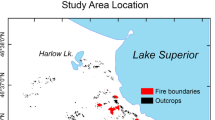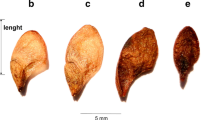Summary
We used the tropical pioneer tree, Cecropia obtusifolia to evaluate the relative importance of different sources of seeds in the regeneration of species that depend on ephemeral sites. We studied seed production in a population established in a 5 ha plot, and dispersal, dormancy and seed predation in two recent treefall gaps (<1 year-old), two building or successional forest patches (10–15 since disturbed), and two mature forest patches (>35 years since disturbed) for a one year period at Los Tuxtlas (Mexico). Flowers and fruits were counted at monthly intervals. Annual fecundity per tree ranged from 1.4×104 to 1.4×107 seeds. Seeds were continuously available on the trees and on the ground. Average annual seed rain per m2 (as measured by 0.5×0.5 m seed traps) varied from 184 to 1925 among the six sites. Distance to nearest seed source and patch type explained more than 60% of the seed rain variation among sites. Soil seed density, estimated by counting seeds from ten samples (78.5 cm2×10 cm deep) collected from each site in October and January, ranged among the six sites from 269 to 4485 seeds per m2 in January and from 204 to 5073 in October. Soil seed viabilities were much lower (17.1% in October and 5.1% in January) than those of rain seeds (48.26%). Annual survivorships of 2.2% were estimated for seeds artificially sown on the soil surface of a gap and a mature patch, and 3.75% in a building patch. In two other experiments seed removal rates ranged from 27% to 98% in 4 days. Removal rates were significantly higher in gap and mature patches than in building patches. Ants (Paratrechina vividula) and grasshopper nymphs (Hygronemobius. sp.) were the main predators. We draw three main conclusions from our data: (1) Pathogens and predators determine low survivorship of C. obtusifolia's seeds in the soil and a rapid turnover rate (1.07 to 1.02 years) of its seed bank; (2) a continuous and copious seed production and an abundant and extensive seed rain replenish the soil seed pool in patches with different disturbance ages at least up to 86 m from nearest source; (3) more than 90% of the seeds contributing to C. obtusifolia seedling recruitment in gaps are less than one year-old. We discuss our results in the context of previous similar studies for tropical forests.
Similar content being viewed by others
References
Alvarez-Buylla RE (1986) Demografía y dinámica poblacional de Cecropia obtusifolia (Moraceae) en la selva de Los Tuxtlas, México, M. Sc. Thesis, UNAM, México
Alvarez-Buylla RE, García-Barrios R (1990) Seed and forest dynamics: a theoretical framework and an example from the neotropics. Am Nat (in press)
Augspurger CK, Franson SE (1988) Input of wind-dispersed seeds into light-gaps and forest sites in a neotropical forest. J Trop Ecol 4:239–252
Berg CC (1978) Cecropiaceae: a new family of Urticales. Taxon 27:39–44
Bosh R, Vázquez-Yanes (1985) Estudio preliminar de la viabilidad natural de las semillas de Cecropia obtusifolia y de los factores ambientales que la modifican. In: Gómez-Pompa A, del Amo S (eds) Investigaciones sobre la regeneración de las selvas altas en Veracruz, México II. Editorial Alhambra, México, pp 255–265
Brokaw NVL (1985) Gap-phase regeneration in a tropical forest. Ecology 66:682–687
Brokaw NVL (1986) Seed dispersal, seedling emergence and gap colonization in a tropical forest. Estrada A, Fleming TH (eds) Frugivores and seed dispersal. Dr. W. Junk Publishers, The Hague, pp 323–332
Charles-Dominique P (1986) Inter-relations between small frugivorous vertebrates and pioneer plants: Cecropia, birds and bats in French Guyana. Estrada A, Fleming TH (eds) Frugivores and seed dispersal. Dr. W. Junk Publishers, The Hague, pp 119–136
Cheke AS, Nanakorn W, Yankoses YC (1979) Dormancy and dispersal of seeds of secondary forest species under a primary tropical rain forest in Northern Thailand. Biotropica 11:88–95
Connell JH (1978) Diversity in tropical rain forests and coral reefs. Science 199:1302–1310
Denslow JS (1985) Disturbance mediated coexistence of species. In: Pickett ST, White PS (edits) The Ecology of Natural Disturbance and Patch Dynamics. Academic Press, Orlando, pp 307–323
Emmons LH (1982) Ecology of Proechimys (Rodentis, Echimyidae) in Southeastern Peru. Trop Ecol 23:280–290
Estrada A, Coates-Estrada R, Vázquez-Yanes C (1984) Observations of fruiting and dispersers of Cecropia obtusifolia at Los Tuxtlas, Mexico. Biotropica 16:315–318
Everitt BS (1977) The analysis of Contingency Tables. Chapman and Hall, London
Ezcurra E, Equihua M, López-Portillo J (1987) The desert vegetation of El Pinacate, Sonora, Mexico. Vegetatio 7:49–60
Fleming TH, Heithaus ER (1981) Frugivorous bats, seed shadows, and the structure of tropical forests. Biotropica 13:45–53
Garwood N (1989) Tropical soil seed banks: a review. In: Leck MA, Simpson RL, Parker VT (eds) Ecology of Seed Banks. Academic Press, New York (in press)
Gómez-Pompa A, Vázquez-Yanes C, Guevara SS (1972) The tropical rain forest: a nonrenewable resource. Science 177:762–765
Guevara SS (1986) Plant species availability and regeneration in Mexican tropical rain forests. Ph.D. Thesis, Upsala University, Sweden
Harper JL (1977) The Population Biology of Plants. Academic Press, London
Holthuijzen AMA, Boerboom JHA (1982) The Cecropia seed bank in the Surinam lowland rain forests. Biotropica 14:62–68
Hopkins MS, Graham AW (1987) The viability of seeds of rainforest species after experimental soil burials under tropical wet lowland forest in north-eastern Australia. Austr J Ecol 12:97–108
Hoppes WG (1987) Pre- and post-foraging movements of frugivorous birds in an eastern deciduous forest woodland, U.S.A. Oikos 49:281–290
Hoppes WG (1988) Seedfall pattern of several species of bird-dispersed plants in an Illinois woodland. Ecology 69:320–329
Horvitz CC, Schemske DW (1986) Seed dispersal and environmental heterogeinity in a neotropical herb: a model of population and patch dynamics. In: Estrada A, Fleming TH (eds) Frugivores and seed dispersal. Dr. W. Junk Publishers, The Hague, pp 169–186
Howe HE, Smallwood J (1982) Ecology of seed dispersal. Annu Rev Ecol Syst 13:201–228
Hubbell SP, Foster RB (1987) Canopy gaps and the dynamics of a neotropical forest. In: Crawley MJ (ed) Plant Ecology. Blackwell Scientific, Oxford, pp 77–96
Hurlbert SH (1984) Pseudoreplication and the design of ecological field experiments. Ecol Monogr 54:187–211
Ibarra GN (1985) Estudios preliminares sobre la flora leñosa de La Estación de Biología Tropical Los Tuxtlas Veracruz, México. B. Sc. Thesis, UNAM, México
Janzen DH (1983) No park is an island: increase in interference from outside as park size decreases. Oikos 41:402–410
Lawton RO, Putz FE (1988) Natural disturbance and gap-phase regeneration in a wind-exposed tropical cloud forest. Ecology 69:764–777
Levey DJ (1988) Treefall gaps in a tropical wet forest and the distribution of understory birds and plants. Ecology 69:1076–1089
Martínez-Ramos M, Alvarez-Buylla ER (1986) Seed dispersal, gap dynamics and tree recruitment: the case of Cecropia obtusifolia at Los Tuxtlas. In: Estrada A, Fleming TH (eds) Frugivores and seed dispersal. Dr. W. Junk Publishers, The Hague, pp 333–346
Martínez-Ramos M, Alvarez-Buylla ER, Piñero DD, Sarukhán J (1988) Treefall age determination in a tropical forest: its uses in the study of gap dynamics. J Ecol 76:700–716
Martínez-Ramos M, Alvarez-Buylla ER, Sarukhán J (1989) Tree demography and gap dynamics. Ecology 70:555–557
McCullagh P, Nelder JA (1983) Generalized linear models. Chapman and Hall, London
Miranda F, Hernández-Xolocotzi E (1963) Los tipos de vegetación y su clasificación. Bol Soc Bot Mex 28:29–179
Moore RP (1973) Tetrazolium staining for assessing seed quality. In: Heydecker N (ed) Seed Ecology. The Butterworth Group, London, pp 347–367
Murray KG (1988) Avian seed dispersal of three neotropical gap-dependent plants. Ecol Monogr 58:271–298
Nelder JA, Wedderburn RWM (1972) Generalized Linear Models. J R Statist Soc A 135:370–384
Paine RT, Levin SA (1981) Intertidal landscapes: disturbance and the dynamics of pattern. Ecol Monogr 51:145–178
Pennington TD, Sarukhán J (1968) Arboles Tropicales de México. Instituto Nacional de Investigaciones Forestales, México
Pérez-Nasser N (1985) Sobrevivencia de cinco especies pioneras en el suelo de la selva de Los Tuxtlas (México). B.Sc. Thesis, Facultad de Ciencias, UNAM, México
Pickett ST, White PS (1985) The Ecology of Natural Disturbance and Patch Dynamics. Academic Press, Orlando
Prevost MF (1981) Mise en évidence d'espèces pionnières dans le sol de fôret primaire en Guyane. Turrialba 31:121–127
Putz FC, Appanah S (1987) Buried seeds, newly dispersed seeds, and the dynamics of a lowland forest in Malaysia. Biotropica 19:326–333
Salmerón RE (1984) Germinación de semillas acumuladas en el suelo de una selva húmeda tropical Los Tuxtlas, Veracruz, México. B.Sc. Thesis, UNAM, México
Sarukhán J (1980) Demographic Problems in tropical systems. In: Solbrig O (ed) Demography and evolution in plant populations. Blackwell, Oxford, pp 163–184
Schemske DW, Brokaw NVL (1981) Treefalls and the distribution of understory birds in a tropical forest. Ecology 62:938–945
Schupp EW (1988a) Seed and early seedling predation in the forest understory and in treefall gaps. Oikos 51:71–78
Schupp EW (1988b) Factors affecting post-dispersal seed survival in a tropical forest. Oecologia 76:525–530
Schupp EW, Howe HF, Augspurger CK, Levey DJ (1989) Arrival and survival in tropical treefall gaps. Ecology 70:562–564
Siegel S (1980) Estadística no Paramétrica. Editorial Trillas, México
Silvertown J (1982) Introduction to plant population biology. Longman, London
Sokal RR, Rohlf FJ (1981) Biometry (2nd Ed). W.H. Freeman, San Francisco
Sousa WP (1984) The role of disturbance in natural communities. Annu Rev Ecol Syst 15:353–391
Vázquez-Yanes CR (1979) Notas sobre la ecofisiología de la germinación de Cecropia obtusifolia. Bertol. Turrialba 29:147–150
Vázquez-Yanes CR (1980) Notas sobre la autoecología de los árboles pioneros de rápido crecimiento de la selva tropical lluviosa. Trop Ecol 21:103–112
Vázquez-Yanes CR, Orozco-Segovia A (1984) Ecophysiology of seed germination in the tropical humid tropics of the world: a review. In: Medina E, Mooney HA, Vázquez-Yanes CR (eds) Physiological Ecology of Plants of the Wet Tropics. Dr. Junk Publishers, The Hague, pp 37–50
Vázquez-Yanes CR, Orozco-Segovia A (1985) Posibles efectos del microclima de los claros de la selva sobre la germinación de tres especies de árboles pioneros: Cecropia obtusifolia, Heliocarpus donnell-smithi y Piper auritum. In: Gómez-Pompa A, del Amo S (eds) Investigaciones Sobre la Regeneración de las Selvas Altas en Veracruz, Mexico II. Ed. Alhambra, México, pp 241–254
Vázquez-Yanes CR, Orozco-Segovia A (1986) Dispersal of seeds by animals: effect on light controlled dormancy in Cecropia obtusifolia. In: Estrada A, Fleming TH (eds) Frugivores and seed dispersal. Dr. W. Junk Publishers, The Hague, pp 71–77
Vázquez-Yanes CR, Smith H (1982) Phytochrome control of seed germination in the tropical rain forest pioneer trees Cecropia obtusifolia and Piper auritum and its ecological significance. New Phytol 92:477–485
Whitmore TC (1978) Gaps in the forest canopy. In: Tomlinson PB, Zimmerman MH (eds) Tropical Trees as Living Systems. Cambridge University Press, New York, pp 639–655
Whitmore TC (1983) Secondary succession from seed in tropical rain forests. For Abs 44:767–779
Young KR, Ewel JJ, Brown BJ (1987) Seed dynamics during forest succession in Costa Rica. Vegetatio 71:157–174
Author information
Authors and Affiliations
Rights and permissions
About this article
Cite this article
Alvarez-Buylla, E.R., Martínez-Ramos, M. Seed bank versus seed rain in the regeneration of a tropical pioneer tree. Oecologia 84, 314–325 (1990). https://doi.org/10.1007/BF00329755
Received:
Accepted:
Issue Date:
DOI: https://doi.org/10.1007/BF00329755




